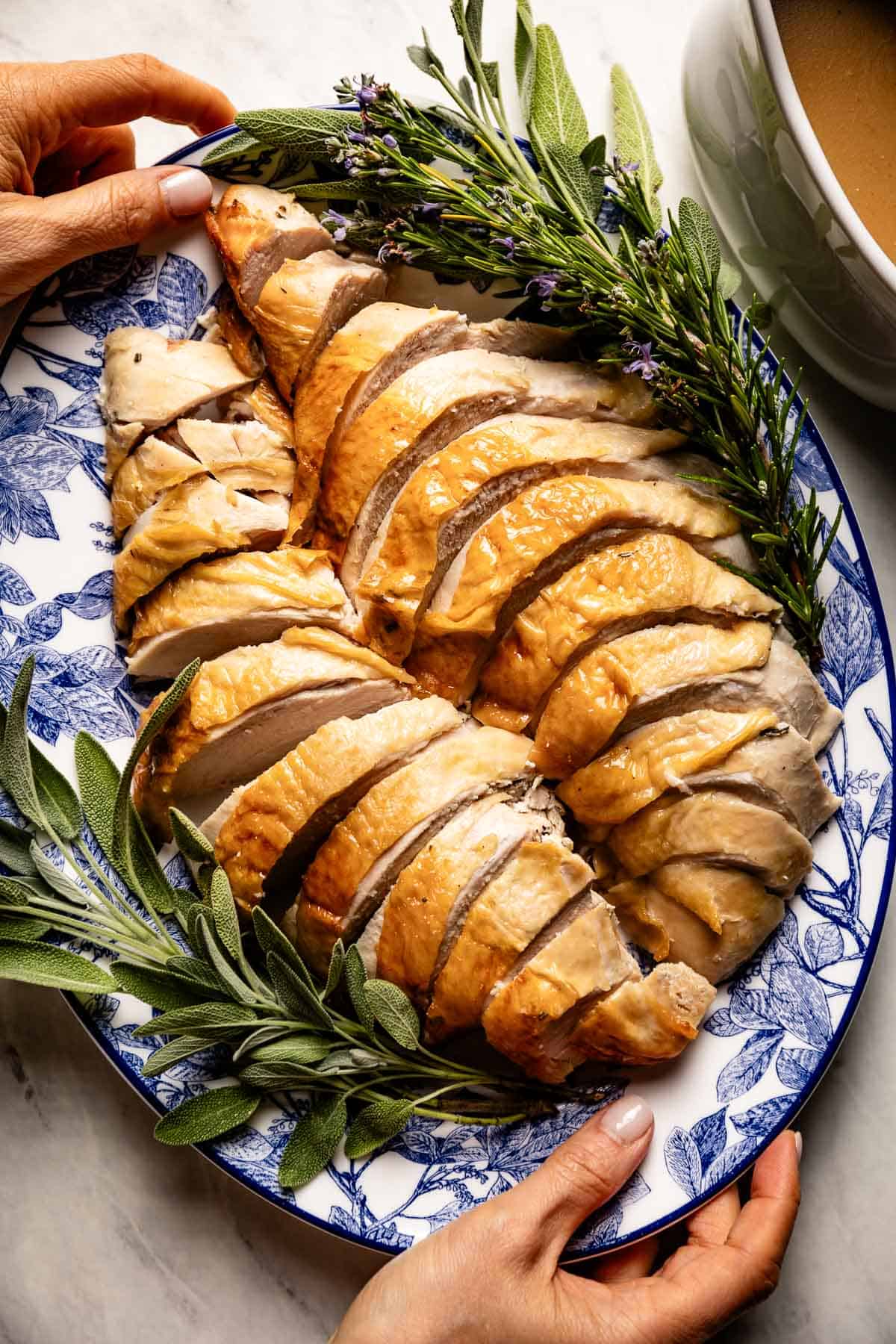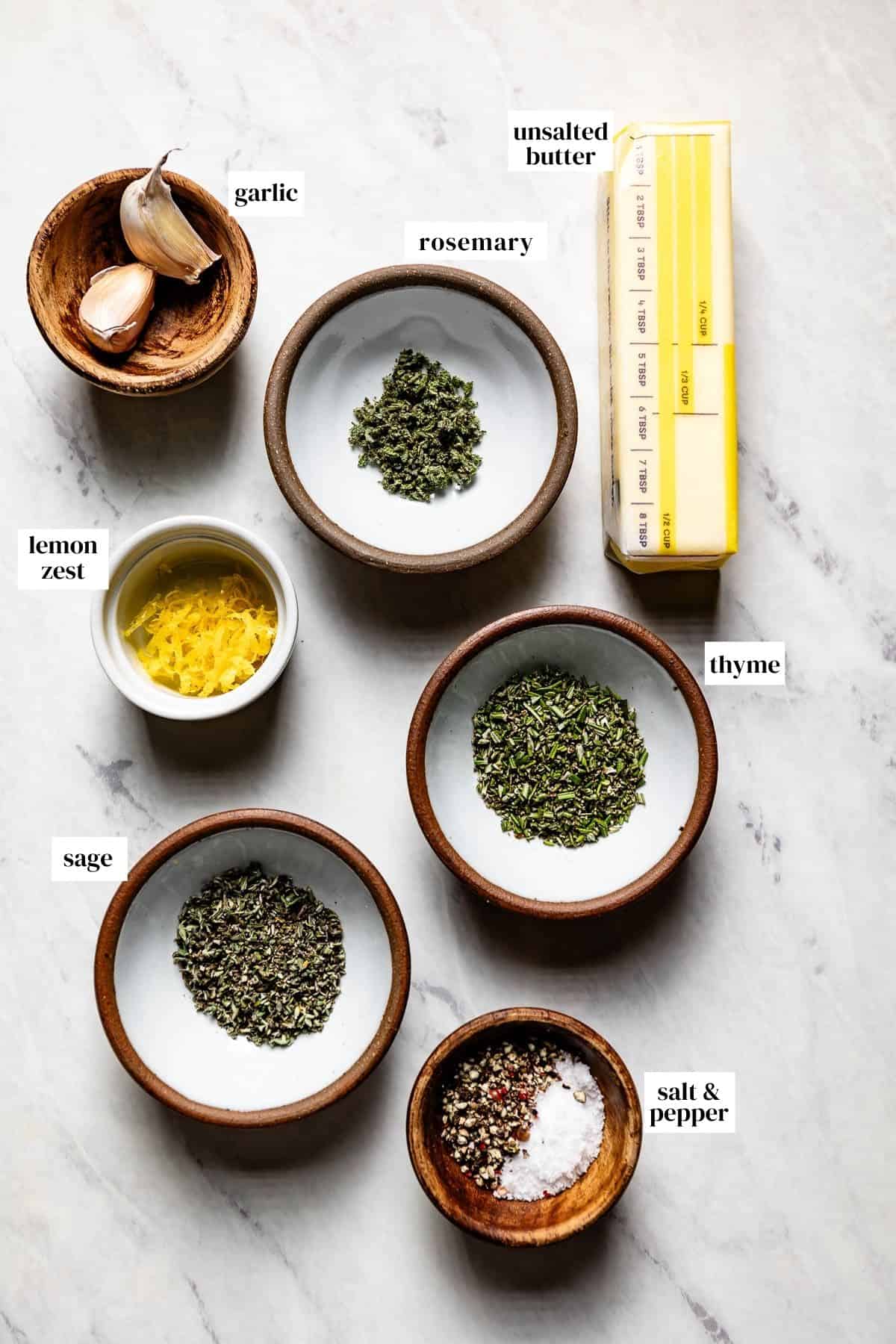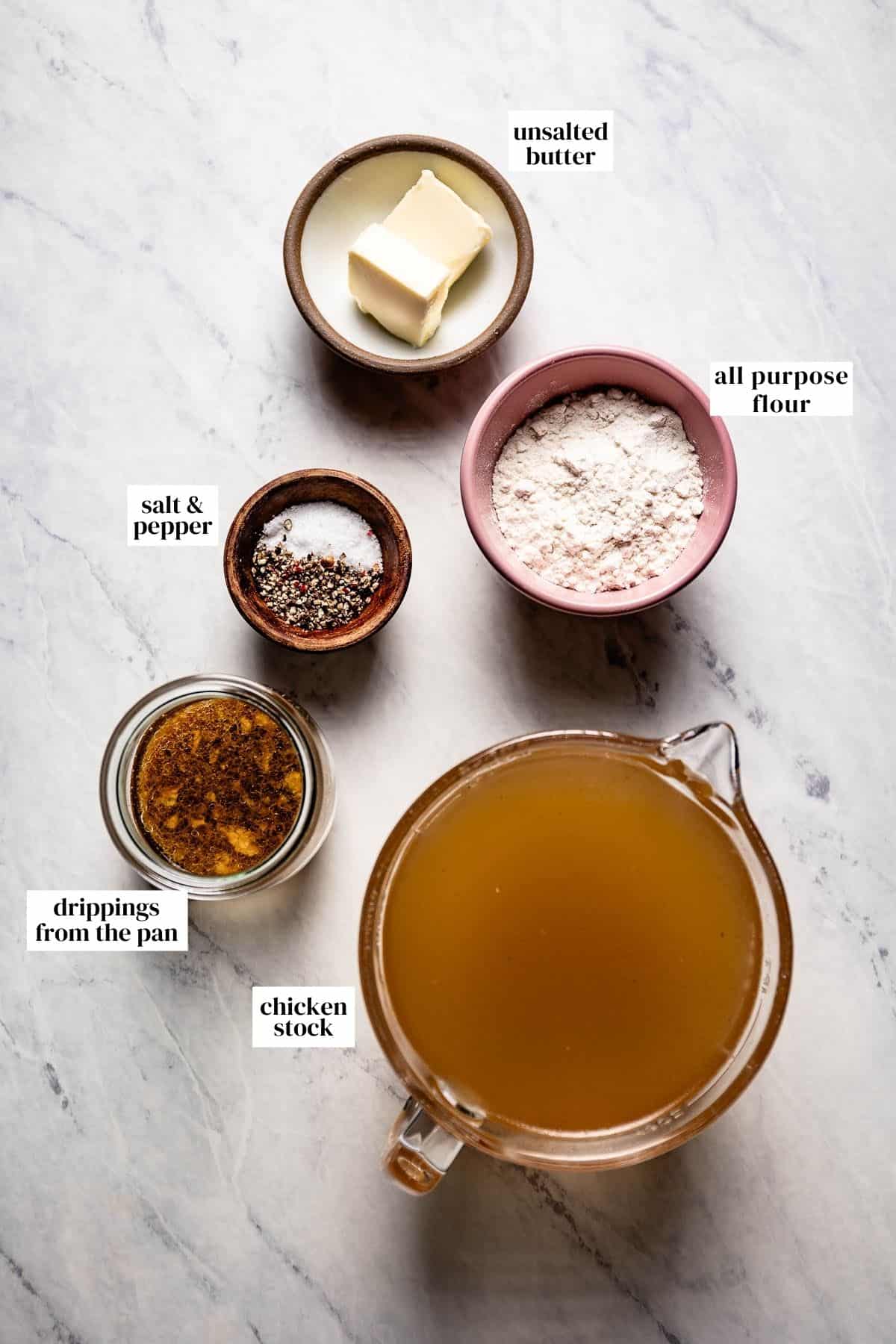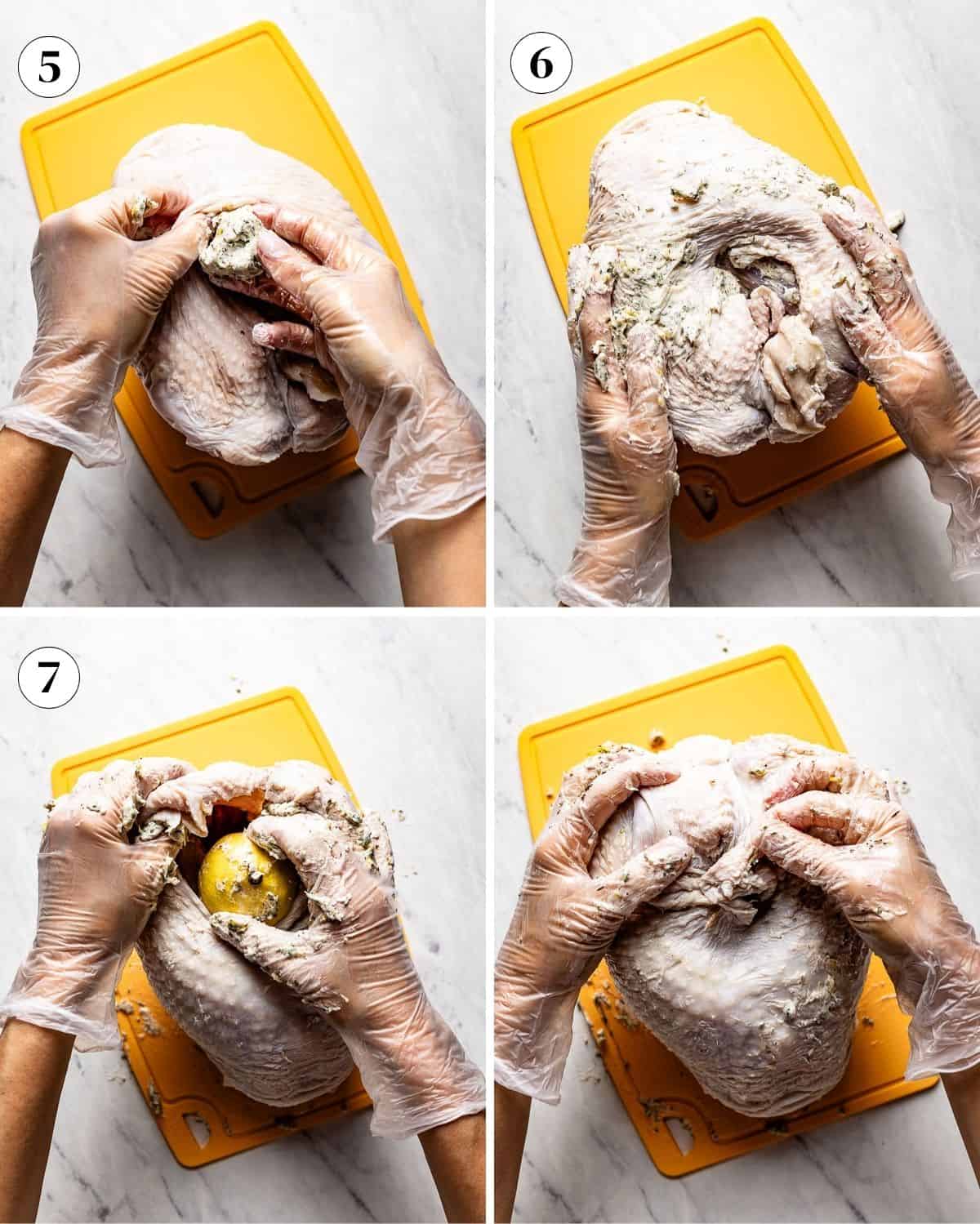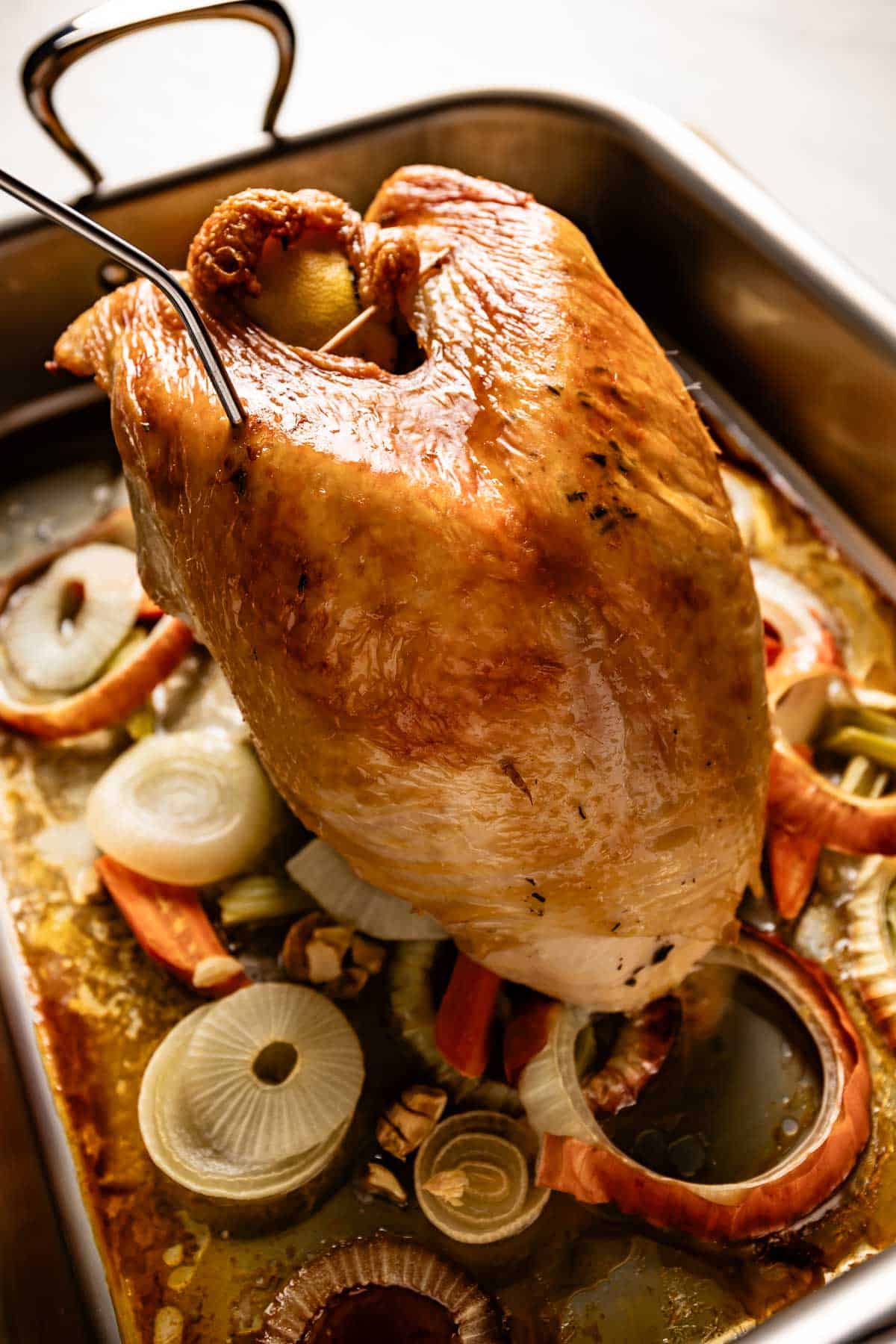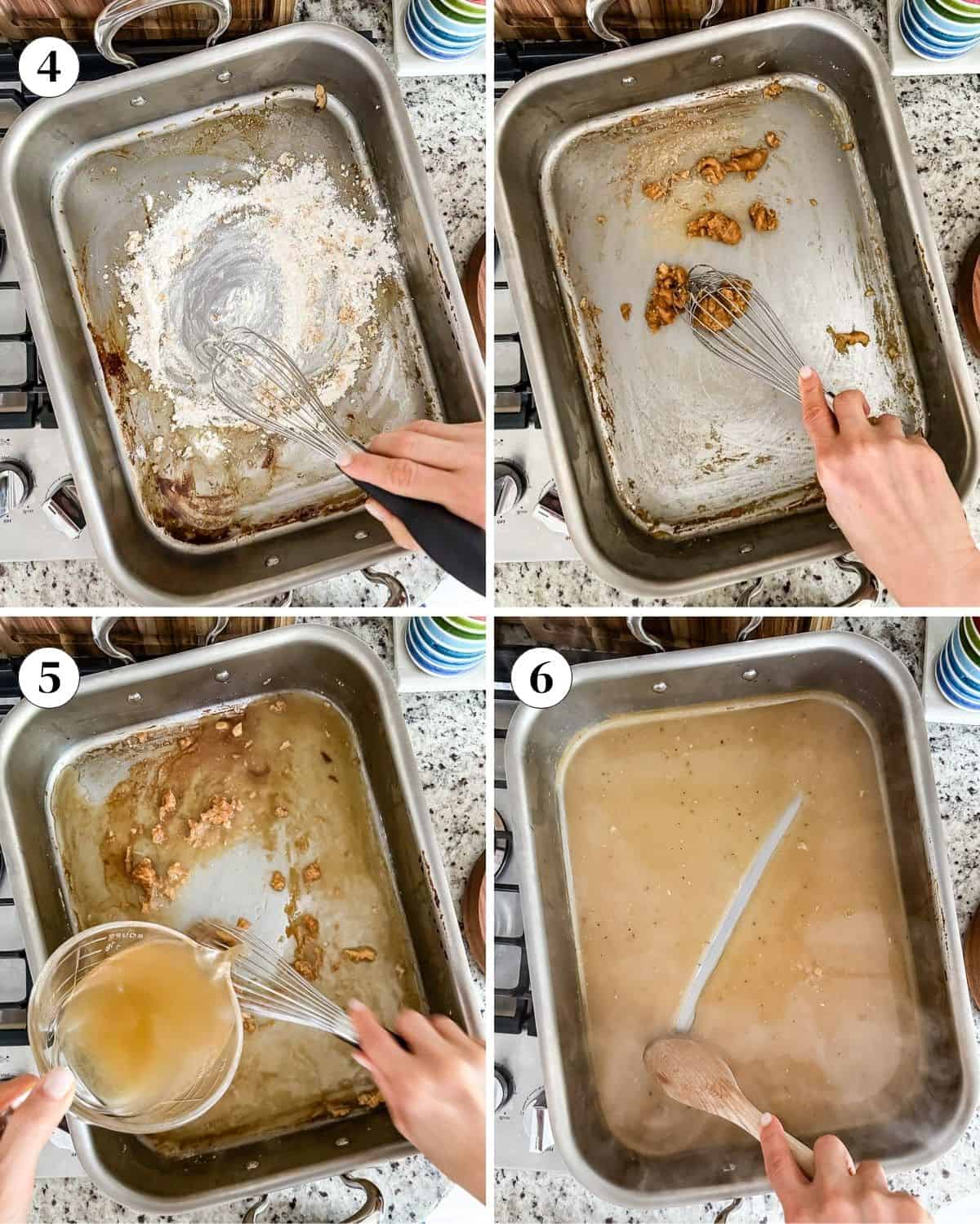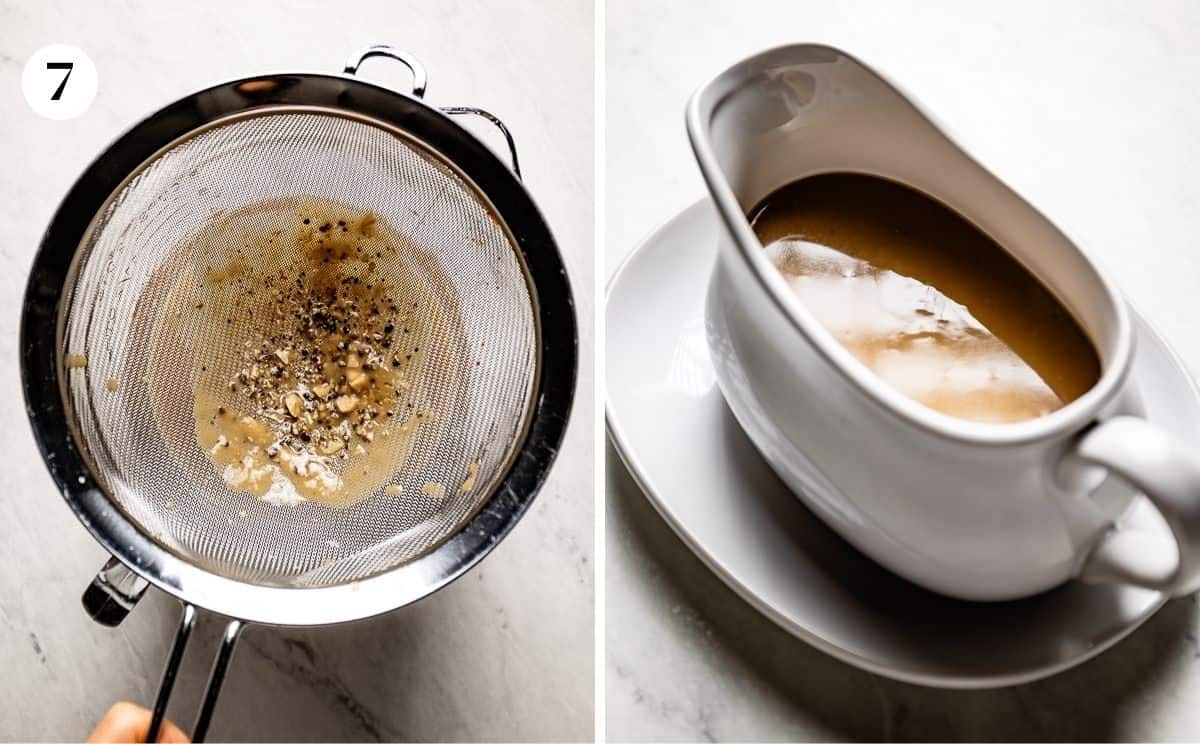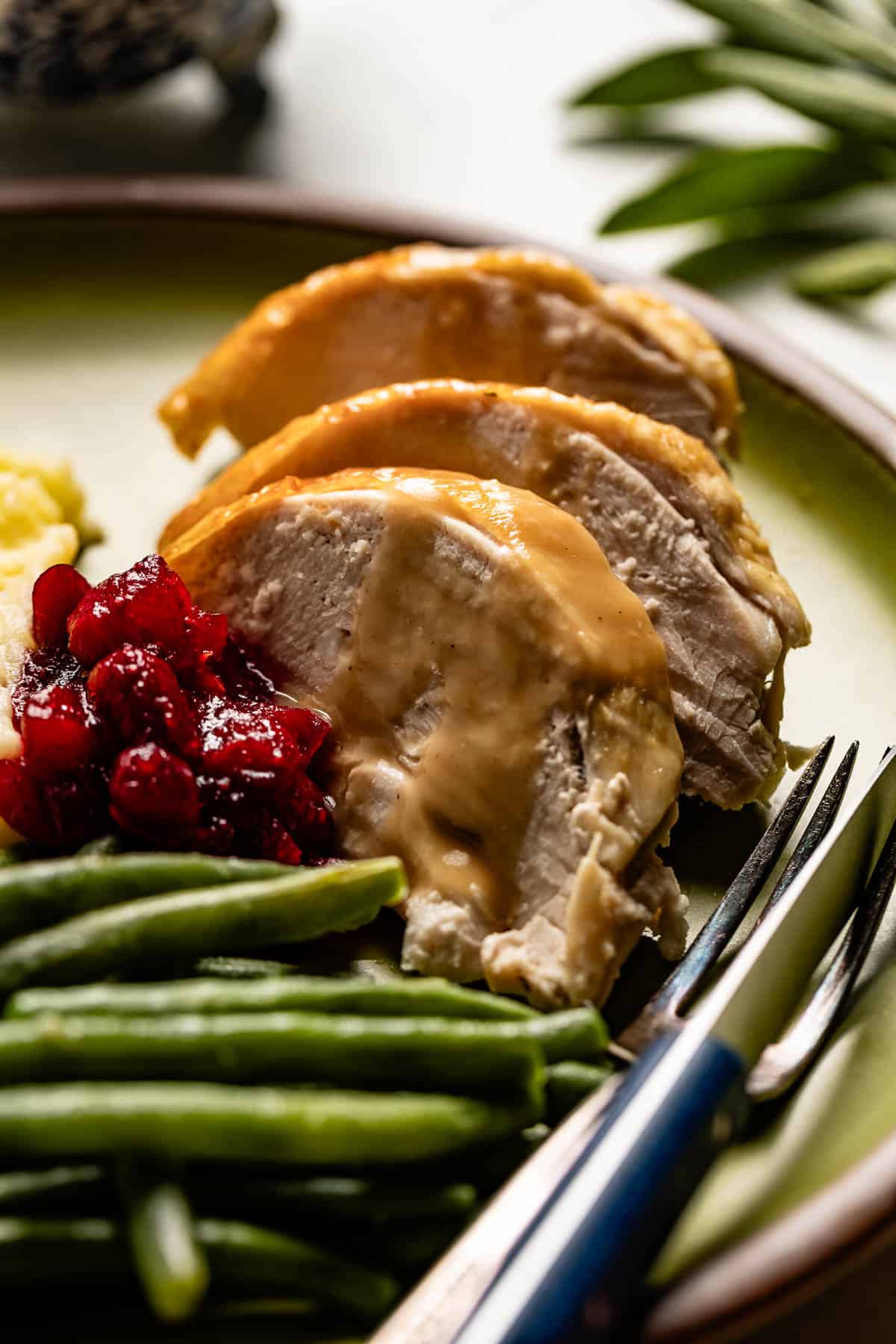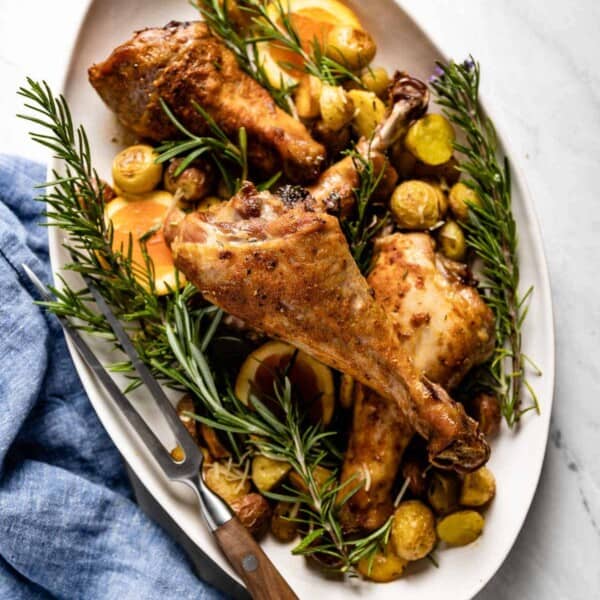We love a juicy turkey breast, but we have so many turkey recipes you can choose from. Our Herb Roasted Turkey, Baked Turkey Wings, Roasted Turkey Loin, and Roasted Turkey Legs (ideal if you like dark meat) are a few that you might also like.
Ingredients You’ll Need
You’ll need three sets of ingredients to make this baked turkey breast recipe: The seasoning, the vegetables and turkey breast, and the gravy ingredients.
Turkey Breast Seasoning
You have a few options for turkey breast seasoning, including a Turkey Dry Rub or Turkey Injection Method. But we used our herbed compound butter because it’s not only super delicious but also makes the drippings delicious for our gravy. While you can use the entire compound butter recipe, we had better results by using half the amount. Here’s what we need for seasoning the turkey breast:
Unsalted butter: We like to use unsalted butter to control the salt, but you can use salted butter. I would reduce the salt to ¼ teaspoon. Fresh herbs (or dried herbs): Hearty herbs like rosemary, thyme, and sage make it feel like fall and hold up well during cooking. If you use dried herbs, reduce the quantity to ½ teaspoon per herb. Garlic: One fresh garlic clove gives us a delicious bite, but ¼ teaspoon of garlic powder would be a great substitute. Lemon zest: The zest from a fresh lemon brightens all the flavors. Seasonings: Stick to a simple seasoning of Kosher salt and freshly ground black pepper. It is optional, but if preferred, a teaspoon of paprika can be added to the mixture.
Turkey Breast and Vegetables
I love roasting a turkey breast because it is faster, easier, and more manageable than a whole turkey. It’s also a great way to satisfy your guests if they are fans of white meat. Here’s what we need for our turkey breast roast:
Turkey breast: We use a bone-in, skin-on-whole turkey breast, also known as a hotel-style turkey breast. A whole turkey breast is two breasts that are joined at the breastbone. If you prefer a half breast (only one breast), ask the butcher to slice the whole breast in half for you. Aromatics: A classic mirepoix blend of onions, carrots, and celery, along with garlic, provides the base. Even more so, the vegetables elevate the turkey breast, creating enough circulation for the turkey so that you do not need a wire rack (V rack) if you don’t have one. Lemon: We like to stuff the turkey cavity with a whole lemon and secure it to the skin with a toothpick. This adds a fresh citrus flavor and helps the skin around the neck remain in place without shrinking during the roasting process. Liquid: Dry white wine, such as a Sauvignon Blanc or Pinot Gris, keeps the turkey breast meat moist while cooking. If you prefer an alcohol-free recipe, use Chicken Stock, Vegetable Stock, or Turkey Stock instead.
Gravy
We need just a few extra ingredients to make the gravy from a turkey breast, including:
Unsalted butter: Again, we like to use unsalted butter to control the salt. Salted butter can also be used, but you’d have to adjust the salt accordingly. Flour: Regular all-purpose flour thickens the gravy to the right consistency. Drippings from roasting pan: A small amount of the pan drippings adds depth and meaty flavor. Stock: You can use chicken stock, vegetable stock, or turkey stock, whatever you have on hand. Seasonings: I recommend tasting the gravy near the end of cooking before adding any more seasoning, as the pan drippings may already be salty. After tasting, add more salt and black pepper if needed.
How to Make Gravy from Turkey Breast?
While the turkey breast roast is resting, it is time to make the homemade gravy. Here are the step-by-step instructions on how to make gravy for turkey breast. However, there are a few essential factors to keep in mind. The turkey breast roast cooking time will depend on the weight of the turkey. First and foremost, the turkey must be thoroughly thawed. I always remove it from the fridge 30 minutes to 1 hour before cooking because the herbed butter is easier to spread, and the turkey is not cold. Following these guidelines, a bone-in turkey breast will take approximately 22-24 minutes per pound at an oven temperature of 325°F (163°C). The internal temperature goal is 155°F (68°C) at the thickest part of the breast as the carry-over heat will help raise it to the safe 165 °F (74°C) as it rests.
How to Store and Reheat?
We all love Thanksgiving leftovers, and we don’t want any of that gorgeous baked turkey breast and gravy to go to waste. Also, while roasting a turkey breast is typically associated with Thanksgiving, having some fresh turkey on hand is a great way to stock your fridge with healthy, lean protein for lunch or dinner. Here are my best storage and reheating instructions:
Storage: Store leftover turkey breast bake and gravy in separate airtight containers in the fridge for up to 3 days. Reheat: Turkey: A foolproof method to reheat turkey is to place the turkey slices in a skillet, add chicken or turkey broth, cover, and simmer gently over medium-low heat for 5-8 minutes. Gravy: Reheat in a small pot over medium heat until bubbly and warm, about 5 minutes.
What to Serve with Turkey Breast Roast
Nothing beats the simplicity of this simple turkey breast recipe. It is easy and show-stopping all at once. If you are serving a small gathering, I keep it simple with Maple Cranberry Sauce. But when I am making this roasted turkey breast for Thanksgiving or an elegant fall gathering, I make sure to have all the classic side dishes. My favorites include:
Thaw your turkey: If your turkey breast is frozen, safely and completely thaw your frozen turkey breast in the fridge. Place the unopened turkey on a baking sheet (to catch any juices) and thaw in the fridge. It takes about 24 hours to thaw every 4 pounds of turkey, so your turkey breast can take anywhere from 36 – 48 hours, depending on the weight. Once thawed, the turkey should be baked within 1-2 days. Remove the turkey from the fridge before cooking: For the most even cooking, remove the thawed turkey from the refrigerator at least 30 minutes or, better yet, an hour before roasting. Make the compound butter in advance: The herbed butter compound can be made 3-5 ahead of time. Having it ready cuts down the prep time in half. Equipment you need: While you can bake the turkey breast in a large casserole dish, we had even greater success with a roasting pan (affiliate link) because you can easily roast the turkey and then make the gravy on the stove while it rests. You can prop the turkey up on the included v-rack, but we didn’t find it necessary. Be gentle as you are distributing the butter under the skin: Be gentle and go slow while spreading the butter under the skin. You don’t want to tear the turkey skin, as it will expose too much of the flesh while cooking. Use a meat thermometer: We loved a Digital Meat Thermometer with a probe (affiliate link) as it is one of those kitchen gadgets that allows you to preset a temperature alarm, meaning there is no guessing and opening and closing the oven. That said, you can use a regular instant-read thermometer (affiliate link.) I would recommend checking at the 1 ½ hour mark, then checking every 10 minutes after that until the turkey is cooked to 155°F (68°C) at the thickest part of the breast. Let the turkey rest: Allowing the turkey to rest for at least 30 minutes helps the juices redistribute, meaning a juicy, succulent turkey. Also, if you use a digital probe thermometer, do not remove it until after the turkey has rested. You don’t want all the good juices to escape! Letting the turkey rest with the thermometer still in place prevents any openings that could cause those flavorful juices to leak out, ensuring every bite is moist and delicious. Cook the flour: Cooking the flour before adding the stock removes that pasty, raw flour flavor and creates a deeper, almost nutty flavor. The roux is ready when it smells like roasted nuts or popcorn. Thickness of the turkey gravy: The gravy will thicken as it sits and even more so when stored in the fridge. You can thin it out with more stock (¼ cup at a time), just make sure to check for seasoning after adding more liquid.
Mashed potatoes: Give it that classic meat and potatoes pairing with Rosemary Garlic Mashed Potatoes (as pictured), Potato Roses, or Sweet Potato Mashed Potatoes. Stuffing: Serve it with chestnut stuffing or wild rice stuffing if you want to go more traditional. Roasted vegetables: You can’t have turkey without some colorful roasted veggies to go with it. I love to pair it with Roasted Butternut Squash, Butter and Garlic Green Beans (as pictured), and/or Baked Sweet Potato and Brussels Sprouts. Salad: Give your guests a lighter touch with any of our fall salads or seasonal Butternut Squash Salad.
If you try this Roasted Turkey Breast with Gravy recipe or any other recipe on Foolproof Living, please take a minute to rate the recipe and leave a comment below. It helps others who are thinking of making the recipe. If you take some pictures, share them on Instagram using #foolproofeats so I can share them on my stories.
Turkey Tenderloin Recipe
Turkey Drumstick Recipe
Turkey Wings Recipe

